Text
Day Twenty-Eight: All Good Things Must Come to an End; Final Thoughts
The itinerary for this last day was to include a visit to the Jim Thompson House and then my transfer to the airport for the flight home. But since I’d already visited the Jim Thompson House on the day I arrived in Bangkok, I had the entire day to myself.
So, I decided to divide it (like Caesar's Gaul) into three parts. First thing in the morning, while it was still cool (or more accurately, when it was only blazingly hot but not to the point where it would cause you to combust spontaneously), I decided to take a stroll around Bangkok’s Chinatown because my hotel was right in the middle of it.
Here is about one minute of a three-minute stroll through the morning market:
If you want to see the full three-minute clip, you’ll need to go to shared photo album. I’m delighted to bring you the sights and sounds out this market, but not (fortunately or not) the aromas.
Of course, what Chinatown would be complete without a Mister Hotdog directly across the street from a Texas Suki and a shop selling “Authentic Chinese Cuisine”?

And it’s always nice to be reminded that “We are a part of your delicious.”
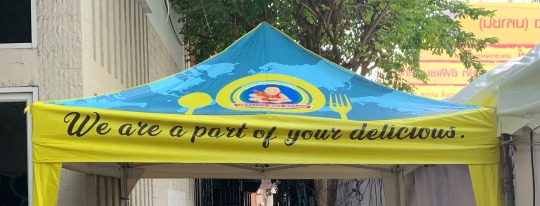
In my walk, I chanced upon a small neighborhood shrine

that was complete with gifts, which had just been brought there by people on their way to work that morning.
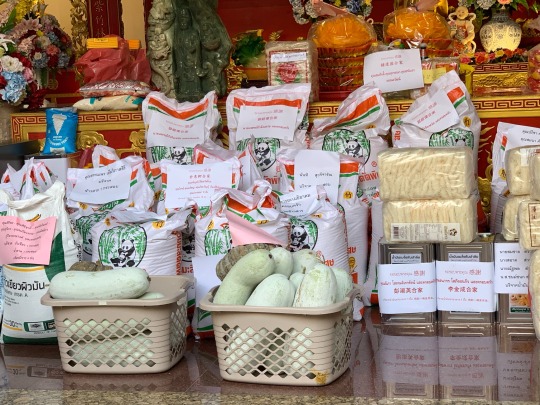
Then, a bit later, I saw this lovely statue of Confucius
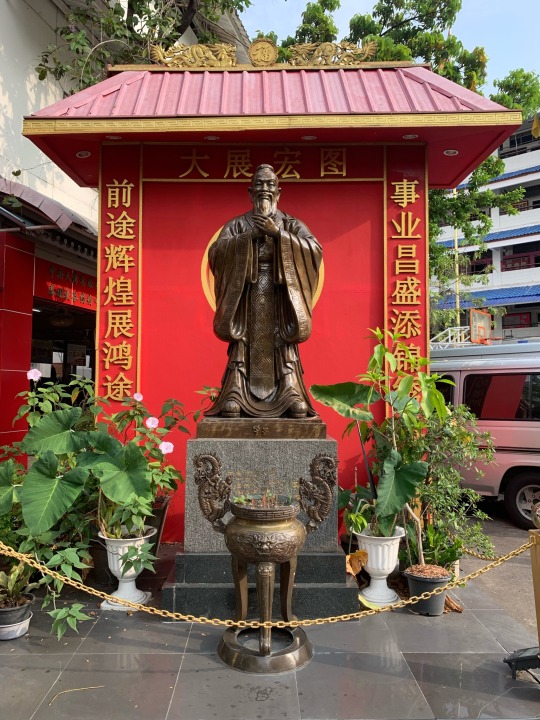
and a singularly elegant spirit house with a prang on top.

The non-random part of my walk was my one pre-determined destination: the Wat Traimit,
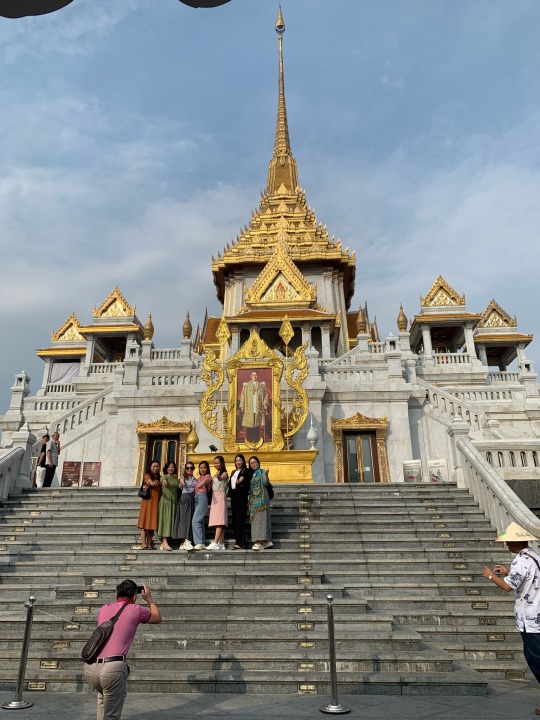
Temple of the Golden Buddha.

Now perhaps, if you’ve been keeping up with this blog, this must be a temple of a golden Buddha since you've already seem more than your fair share of golden Buddhas. Ah, but here’s the difference. All the other golden Buddhas were made of other materials and then covered with gold leaf. This particular Buddha is solid gold, 15’9” high and 12’5” wide, weighing 5.5 tons … of solid gold. In times of invasion, the statue was covered with plaster so that it would look less valuable than it was.
In time, since the statue looked as though it was merely made of plaster, people forgot what was inside. Only in 1955, when there were plans to move the statue from another site to here at the Wat Traimit, did some of the plaster fall off, and it became clear that underneath a shallow façade was a virtual mountain of gold.
And today, if you like, you can buy a pre-packaged bottle of holy water at the temple for only twenty baht.

After visiting the Golden Buddha, I returned to the hotel for breakfast, a shower, and a brief rest before checking out.
The second part of the day has not yet occurred, but I need to post this entry now while I have access to the Internet. Since I’ve yet to experience Thai massage or, for that matter, any massage in Southeast Asia, I've booked a few hours in a spa this afternoon between my check-out time and my departure for the airport. Thai massage is one of the things that people often talk about after visiting Bangkok, and I have a few empty hours on my hands, so …
When booking the appointment I told them that my spa visit would occur shortly before a thirty-hour flight back home, so I wanted to feel “clean and refreshed but also relaxed.” They assured me they have “just the thing.” (When do businesses not have “just the thing” when you make an inquiry?) I'll be in for a body cleanse and scrub, followed by a gentle aromatherapy massage.
We’ll see how that goes. If you truly want to know, ask me in person sometime.
Now, the third part of my day will be to engage in a bit of post-trip reflection. And I've already given that topic a lot of thought during my walkabout this morning. So, here goes.
This experience in Southeast Asia was one of my long-term goals. You might even say it was a life goal. At least, it was something I'd talked about for years and felt I absolutely needed to do. So, life goal accomplished!
But here's the funny thing about life goals. Once you achieve them, you have mixed feelings. On the one hand, there's a major sense of accomplishment. On the other, it feels as though a milestone in life has now past, and you wonder whether there will ever be other goals that you’ll long for quite that much. Not to exaggerate, but it feels as though a part of your life is now over and that you’ve passed one more signpost on the road toward mortality.
I remind myself that I’d had similar feelings before. When I was very young, my life goal had been to get a Ph.D. and become a college professor. (Seriously. I remember telling people this as early as fifth grade.) Then, when I was 26 and had achieved that goal, I thought, “Well, now what?”
Other goals came along, of course. There was a period when, if people asked whether I had a “bucket list,” I’d say, “I want to do three things. See the pyramids in Egypt, visit Kyoto, and attend the Wagner festival at Bayreuth.” Then, by a strange turn of fate, I did all three of those things within the same six-month period and again thought, “Now what?”
But there was always that Southeast Asia trip left for me to plan. So, now it's over. Okay, now what?
The honest answer is “I don’t know” but also “I’m sure I’ll think of something. I always have.”
As this trip comes to an end, I find myself reminded of that article I mentioned on Day Nine: “The Case Against Travel.” The author’s argument was that people always say they travel because travel changes them, but everyone returns from a trip no different from the person they were before setting out.
So, am I the same person I was before this trip?
Absolutely.
But I don’t really think that’s the point. Certainly, there can be zen-like, blinding flashes of insight during a trip, like a flash of gold appearing from beneath a thin façade of plaster. I already mentioned once being in Rome and realizing, “Oh! That’s what Horace meant in his poetry!” and never seeing his works in the same way again. But those experiences are rare.
More often, travel changes you slowly over time. You don’t see those changes in a single day, a single week, or even a single year. Rather it’s like the slow polishing of a stone into a statue. It takes time. It happens almost imperceptibly. And eventually you realize that you actually aren’t the same person you were before. You’ve broadened your perspective, left behind a few assumptions, and made connections between ideas you never would've made before.
That’s a good thing.
No. I'm wrong.
That’s a great thing.
In fact, as far as I’m concerned, it’s one of the best things a person can do.
And I wonder where I’ll go next and how that experience might change me.
I can't wait.
3 notes
·
View notes
Text
Day Twenty-Seven: Bonus
It’s late. I have packing to do, and I really need to get to bed. But since tomorrow is the last day of the trip, I feel I ought to start doing some “wrapping up.” I’ll save the larger philosophical issues for tomorrow. But here are a few random (and very minor) things I learned over the last four weeks.
As is common in Eastern countries, religious sites and many homes and businesses in Southeast Asia will have a raised threshold that you have to step over before entering. Almost always, you have to remove your shoes before doing so. A set of racks is helpfully placed nearby. If you ask someone why there's a raised threshold, these are among the answers you will receive:
1. To keep water out during heavy rainstorms.
2. To keep small animals out.
3. To keep evil spirits out.
4. To keep crawling babies in. (This reason is usually only given at private homes.)
5. Because, in order to step over the threshold, you have to look down. You are thus bowing and giving the place you are entering a sign of respect.
In most cases, I was given two of these reasons, typically one of them “practical” and the other one “spiritual.” But they were rarely the same two reasons as I moved from place to place. People tend to mix and match their explanations according to their personal beliefs or local custom and then to generalize those explanations.
Also, it is generally protocol to step over the raised threshold, not on it. Once, however, I was surprised to see one of my guides step directly on the threshold. I was (I must admit) a bit shocked, and I said, “I thought you weren’t supposed to do that."
He looked at me with some surprise and replied, “Meh. Old superstition. No one believes that anymore.”
I suppose I should've known this, but I also learned that Vietnam, Cambodia, and Laos are considered Indochina, but Thailand isn’t. That division both makes sense, and it doesn’t. It doesn’t make sense because the borders of all four countries have been highly fluid throughout history. Territory that was part of one country for a certain number of years often became part of another country later. And just keeping track of all those shifts can be an intimidating task.
But it makes some sense, too. There’s a different “feel” when you move from Indochina to Thailand. One rather obvious shift: Because of French influence, people drive on the right in Vietnam, Cambodia, and Laos. Because of British influence, they drive on the left in Thailand. It's a small change, but it's noticeable.
In addition, Vietnam, Cambodia, and Laos have had a major and lasting influence of the Communist Party. They’ve gotten rid of their kings, and they seem quite happy about that. Thailand still has its king, and the Thais seem pretty happy about that, too. Suum cuique.
As a result, Thailand was an ally of the US when the US was waging war in Indochina. That war has left deep scars in those countries, particularly in Vietnam and Laos. If the impact of what the French and Americans did in this region seems less of a daily presence in Cambodia, it’s only because (as the Cambodians will freely tell you) they did worse things to themselves … and they will tell you this with that haunting Cambodian smile. There are similarities but also important differences among the peoples of this region.
It has been a somewhat unreal experience “vacationing” in cities and regions with names that, when I was growing up, were daily mentioned on the news as war zones. Hanoi. Da Nang. Cambodia. Laos.
It was unreal but also, in a strange way, affirming. If those places that were once so associated with bombing and death are now places where we can go for culture and relaxation, who’s to say that other spots that today are associated with bombing and death may not also one day be places where future generations go on package tours “to get away from it all”?
Maybe someday someone will be writing a diary about a leisurely month they spent in Ukraine or Gaza and commenting on things so seemingly trivial as which side of the road people drive on.
We can only hope.
2 notes
·
View notes
Text
Day Twenty-Seven, Part Four: An Excursion to Ayutthaya
Outside Wihan Phra Mongkhon Bophit is a statue that worshippers can adorn with small pieces of gold leaf. Some people put the leaf wherever the statue is bare. Others put it near a place where they themselves are having a health problem.

Instead of riding back in the van, we traveled by boat along that Chao Praya river.
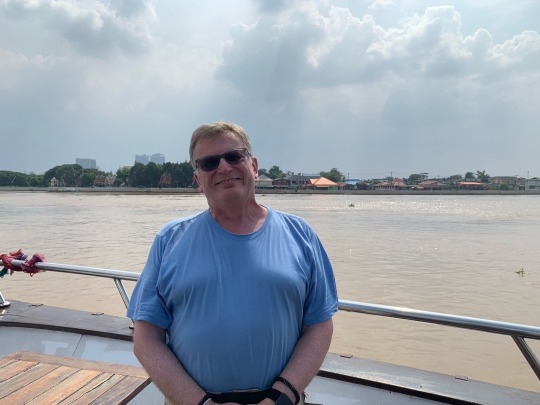
On ourway, we passed many other temples, with some golden Buddhas,
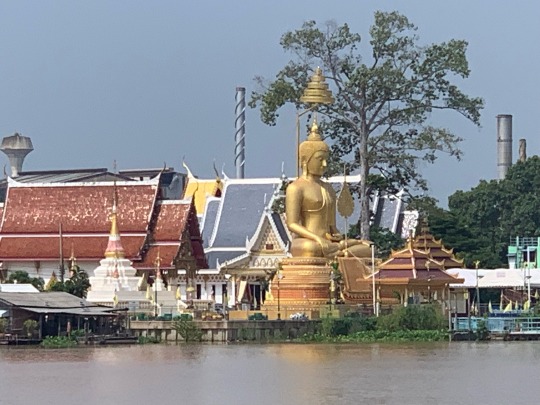
and others with Buddhas painted all in white.
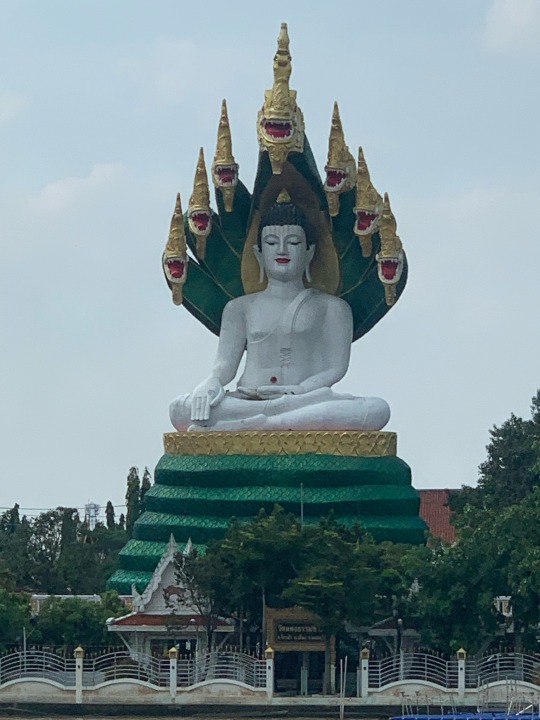
We also passed the new parliament building.
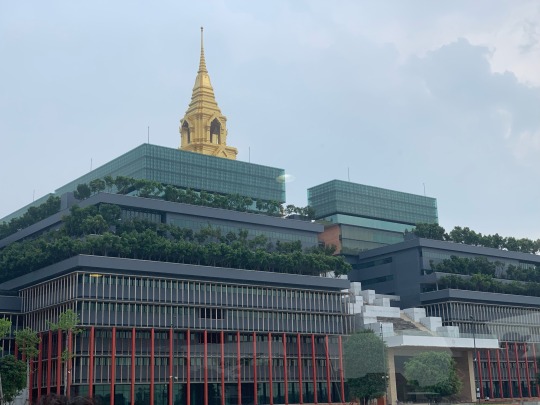
As we were coming into Bangkok, I took the only selfie I allowed myself on this trip.

With the river running high from the rainy season, we barely cleared some of the bridges. For once, being rather short (5'8") was a rather good thing.
We docked at River Center, an intriguing art center in Bangkok. Here, there are easels people can rent in order to paint along the river,

and a soundproof music study where one can make recordings. Notice all the harps.

1 note
·
View note
Text
Day Twenty-Seven, Part Three: An Excursion to Ayutthaya
A crude stone type of known as laterite was often used as the foundation of temples and in parts of the building that would not be seen, similar to how the Romans sometimes used tufa. Laterite would either be covered by a higher quality of stone or with concrete.
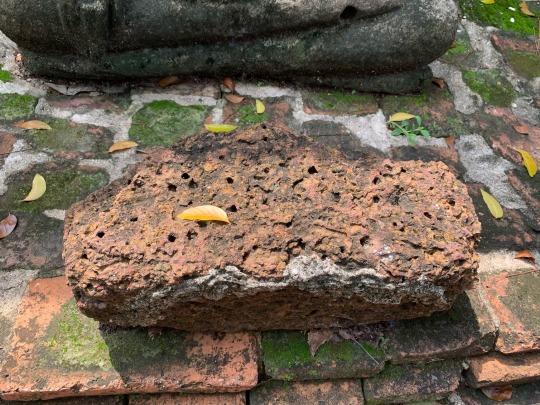
Bricks were also commonly used, although these, too, would have been covered by concrete.

The main part of Ayutthaya is Wat Mahathat. Next to it is a similar site, Wat Phra Si Sanphet.

This city was built by a different king and is also illustrated with a model that depicts how it looked before it was destroyed.

Its most prominent feature is a series of stupas.
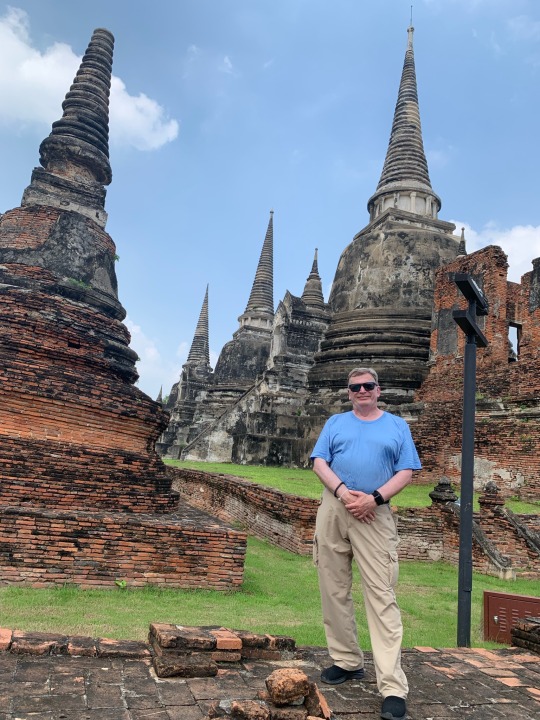
Some of the Buddha statues remain objects of worship even today.
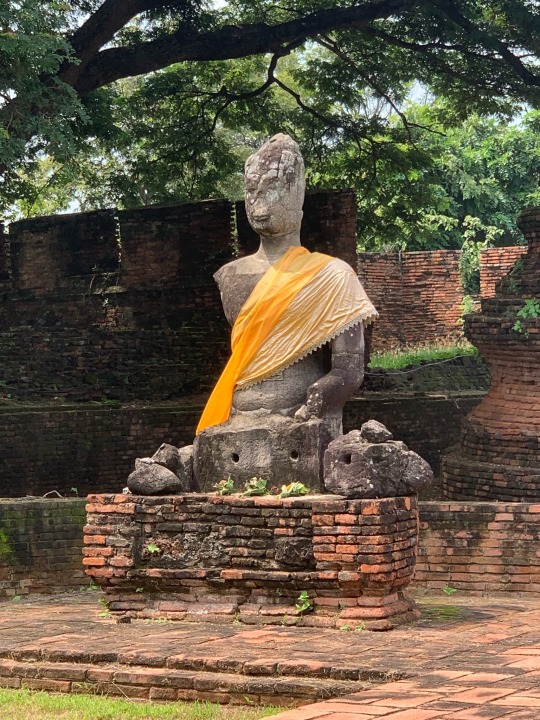
An even more active center for Buddhist worship is the nearby Wihan Phra Mongkhon Bophit, which has a large statue of the Buddha, 12.45 meters high and 9.55 meters wide.

In the old days, it was common for worshippers to purchase a garment for the statue and dress the figure themselves. Nowadays, people can still purchase the garments, but they are simply stacked in a pile, with a thread connecting the offerings to the statue.
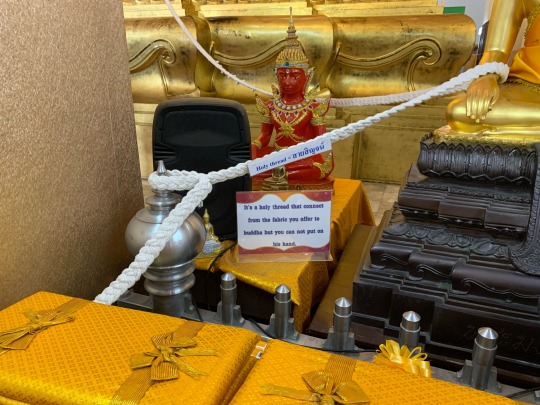
A sign indicates how this system works.

The temple is now heavily restored. Photographs reveal how it looked prior to restoration.

1 note
·
View note
Text
Day Twenty-Seven, Part Two: An Excursion to Ayutthaya
Queens and princesses at Bang-Pa-In have their own mansions.

After visiting this summer palace, we went to the ancient capital of Ayutthaya.

Now a UNESCO World Heritage site, Ayutthaya feels like a combination of Angkor Wat and Pompeii.
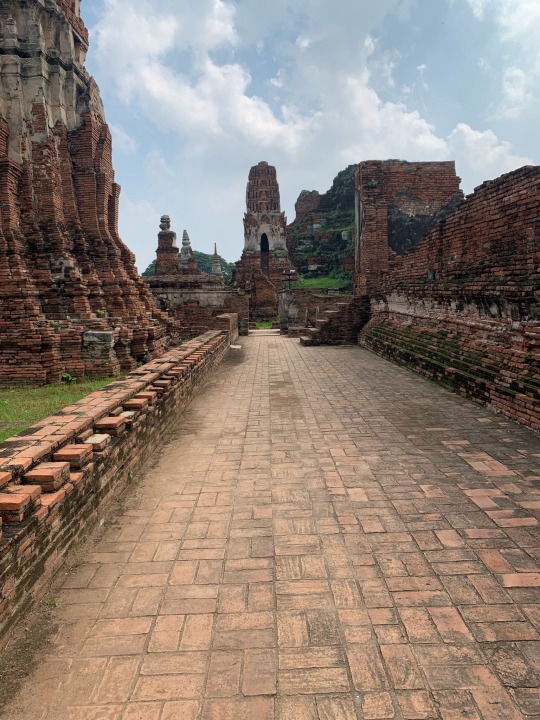
Like Angkor Wat, the temples have towers or “prangs” (Rich called them “corncob towers”) that serve as pagodas.
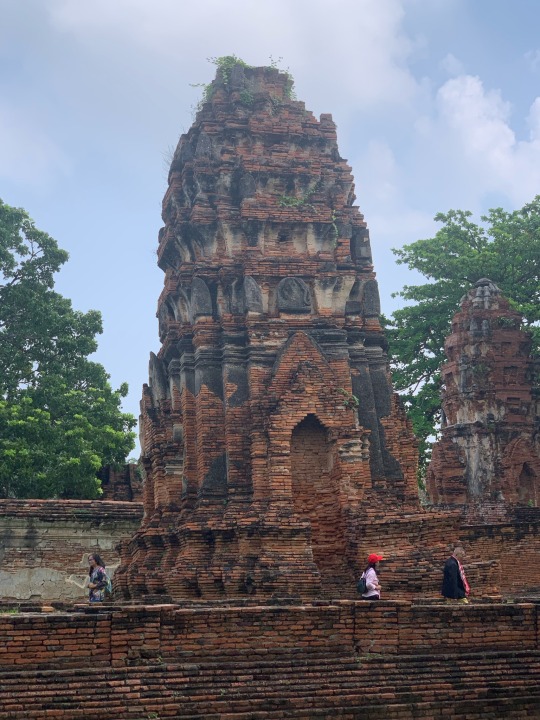
But like Pompeii, the site has the feeling of being caught in a single moment of time.

That’s because Ayutthaya was destroyed by the Burmese, with many of the Buddha figures destroyed, and the wooden parts of the buildings burned.

A model shows what Ayutthaya would have looked like originally.

Some of the buildings now are mere piles of rubble.
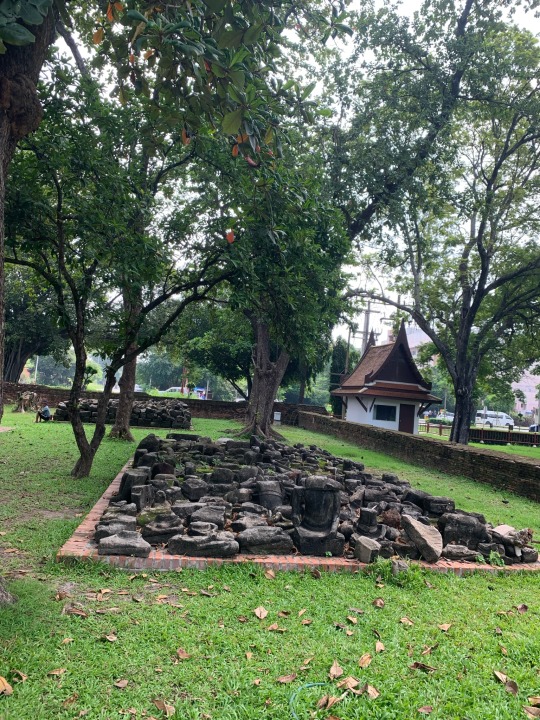
In another, the head of the Buddha has been encased in a tree that grew around it.
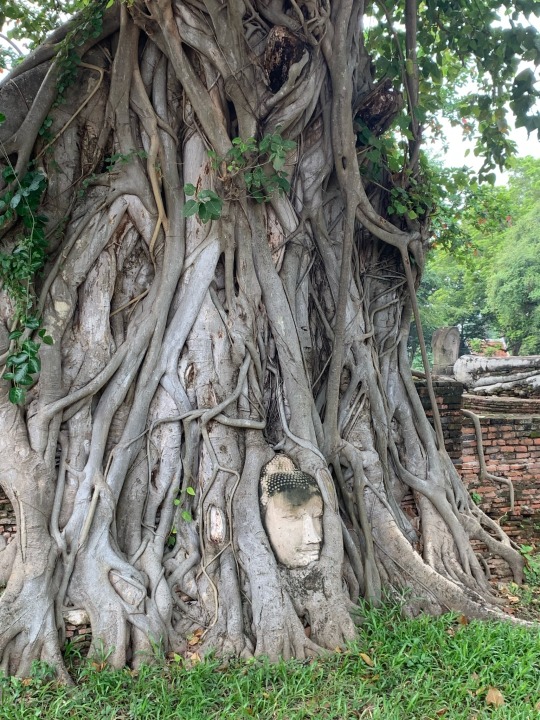
Other Buddha figures remain nearly intact.

1 note
·
View note
Text
Day Twenty-Seven, Part One: An Excursion to Ayutthaya
Since tomorrow is a free day until my ride to the airport for the flight home, today was the last day of my scheduled tour. I spent it about 47 miles north of Bangkok, visiting two major sites. The first was Bang-Pa-In, the summer palace of King Rama V.
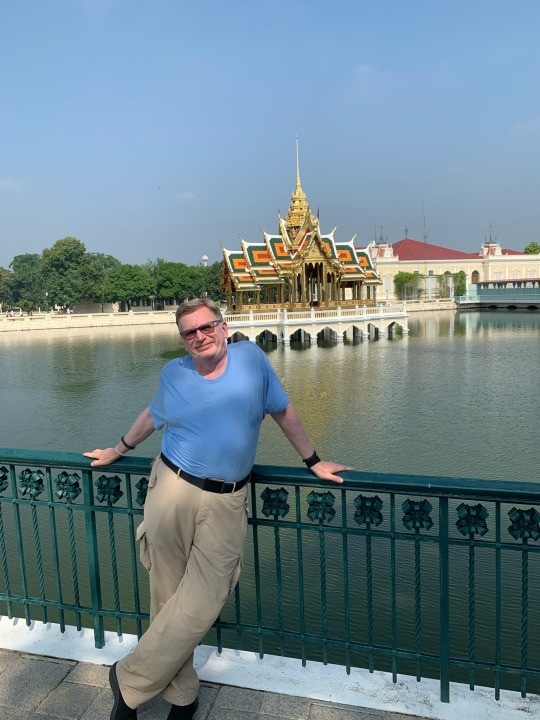
If I was comparing certain parts of Bangkok to Pirates of the Caribbean yesterday, Bang-Pa-In is more like EPCOT: an amazing variety of cultures and styles set side-by-side.

If you look closely, you can see elements of Classical, Gothic, Renaissance, Chinese, and Thai architecture, sometimes in different buildings, sometimes in the same building.
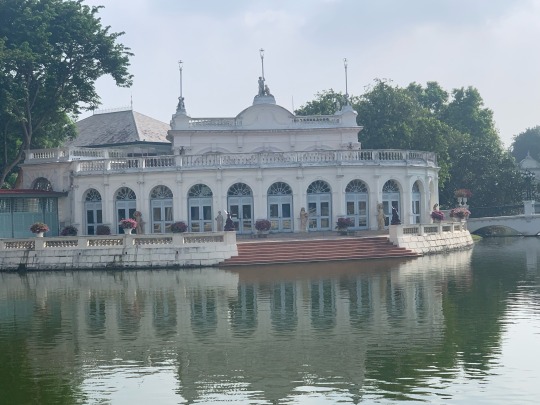
A bridge leading into part of the complex is divided into two parts: a covered area for women,
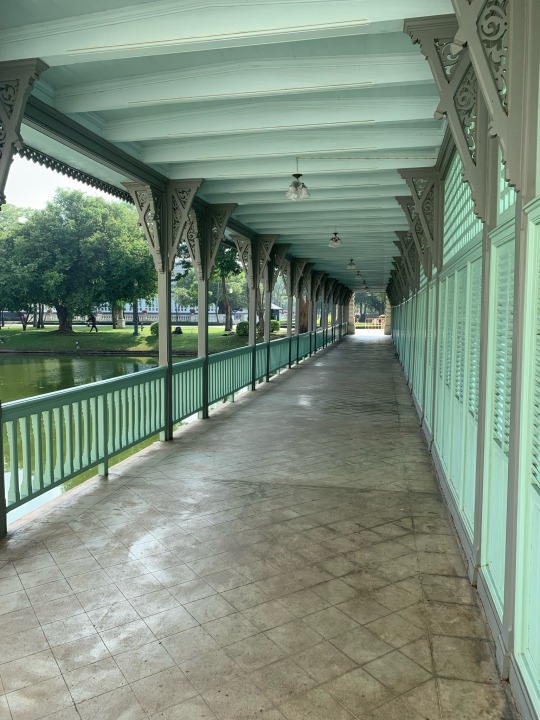
and an open area for men.

The idea was that women of the court were not to be seen by other men.
All over the estate, the Indian cock flower blooms, and its blossoms fall everywhere.
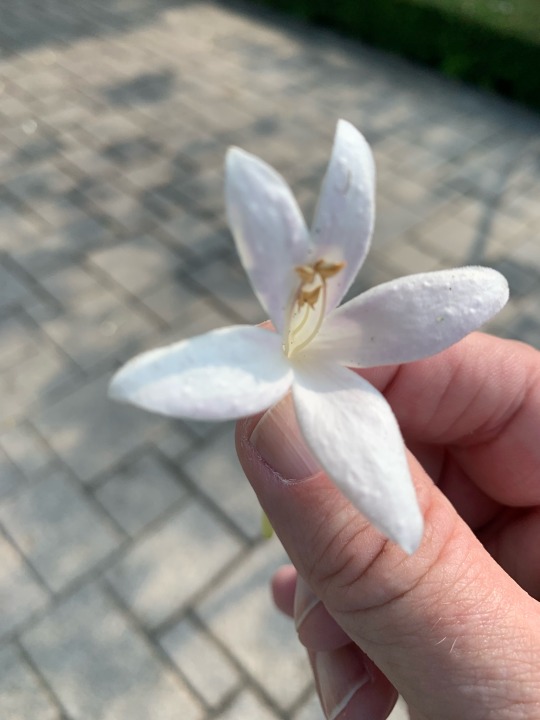
A watch tower served a dual purpose. Soldiers could keep an eye on the surrounding area, but also visiting guests could get a nice view of the property.

Topiary animals are a common feature of the garden.
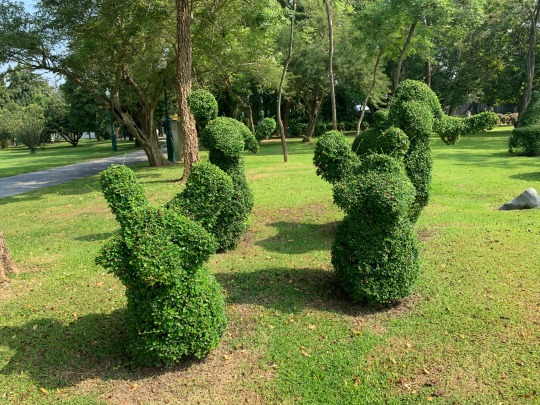
One hall has been completely constructed in Chinese style with prominent red and gold designs.

Even the nearby spirit house continues this theme.

Water on the property is controlled by a series of locks and dams so that the proper level is always maintained.
1 note
·
View note
Text
Day Twenty-Six, Part Four: A Day in Bangkok
At Wat Pho, there is also yet another large standing Buddha.

Earlier in the day, I’d expressed an interest in Bangkok’s new subway system. So, at lunch, Rich asked whether I’d like to go to our next destination by subway. I readily agreed, and off we went.

Our goal was the Salachalermkrung Royal Theater where, if we arrived by 2:30, our tickets to the Grand Palace would give us admission to a dance performance.

The first part of the performance was a survey of historical Thai dances, a little bit like the Apsara Show in Siem Reap. But the second dance was the story of Hanuman, the monkey king, and his pursuit of the mermaid, Suvannamacha, which we’d seen illustrated at the Grand Palace that morning. It was virtually like watching a Thai version of Alberich pursuing the Rhinemaidens (well, one of them, anyway).
Once again, we were strictly forbidden to photograph or record any part of the performance, a rule that I obeyed, but many in the audience flagrantly ignored. Nevertheless, this short YouTube clip will give you some sense of what I saw: https://fb.watch/nK57IYDHtN/?mibextid=v7YzmG
2 notes
·
View notes
Text
Day Twenty-Six, Part Three: A Day in Bangkok
At both the beginning and the end of the boat trip, we had to pass through locks because of the varying depth of the canals.
We then disembarked at Wat Arun where a 76-meter-high stupa is decorated with glazed ceramic pieces that reflect the rising sun and that gave the temple its name: “The Temple of Dawn.”

Rich assured me that pretty much every time I see a structure in Bangkok decorated with Chinese porcelain or broken pieces of it, it was build during the reign of the third Thai king who had a particular fascination with this material.

The stupa is built in layers, with humans at the bottom

and the creatures becoming more and more celestial as you move to the top.
A peculiar custom that arose at Wat Arun is that tourists, typically Vietnamese, buy or rent traditional Thai clothing and bring photographers to have their portraits taken there.

One particularly ornate Buddha at the Wat Arun has the Prabang mudra, a posture that my guide, Rich, described as a “calming the waters” pose.
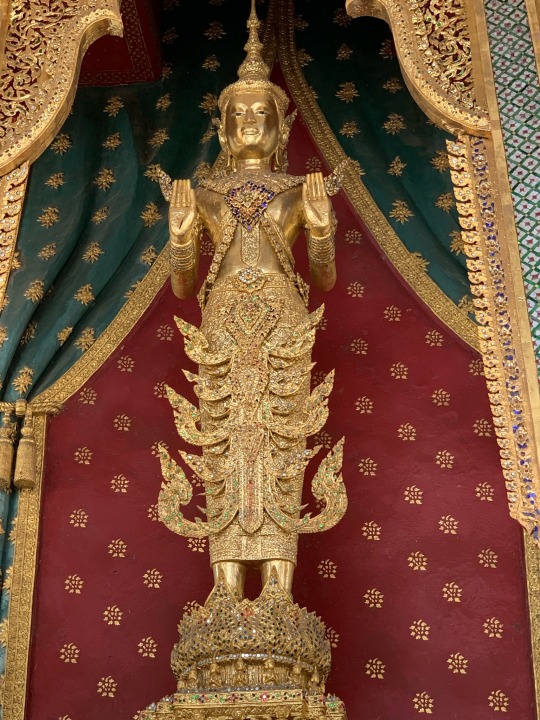
We then took a ferry to the Wat Pho (“The Temple of The Bodhi Tree,” the tree under which the Buddha obtained enlightenment). The Wat Pho does not (and I know you were thinking it) mean “The Temple of Vietnamese Noodle Soup.”
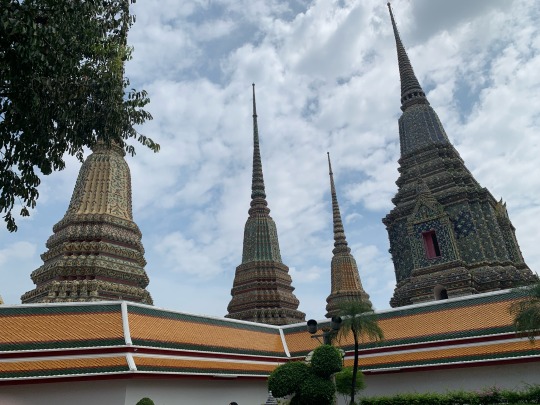
It is this temple where there is a gold statue of the reclining Buddha, 15 meters high and 46 meters long.

The soles of the Buddha’s sandals are adorned with 108 images created from mother of pearl.
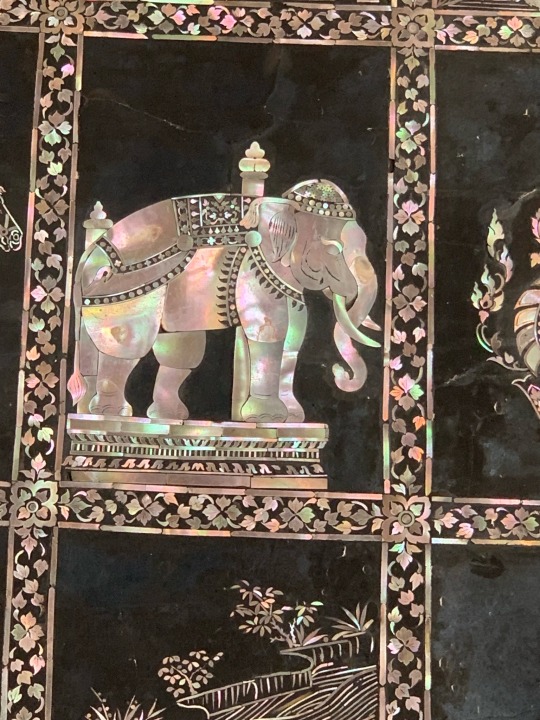
108 is an important number in Hinduism and thus in Buddhism. There are 108 beads in a set of mala beads (a form of rosary), and, behind the reclining Buddha at Wat Pho are 108 buckets. The faithful often come with 108 coins and make a separate wish as they drop a coin in each bucket.
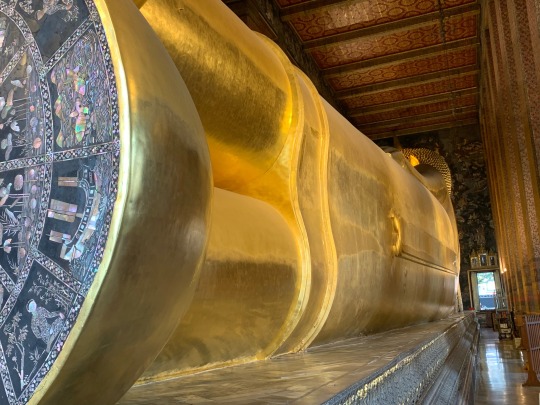
As you leave Wat Pho, you pass a number of courtyards that contain dozens of Buddha statues, most of which were recovered when the Burmese sacked and burned Ayuthaya (pronounced: eye-YOU-thee-uh), tomorrow’s destination.

2 notes
·
View notes
Text
Day Twenty-Six, Part Two: A Day in Bangkok
Within the compound of the Royal Palace is Wat Pra Kaew (“The Temple of Emerald Buddha”).

This particular statue had once been in several of the cities I visited, only to be carried off in one battle after another and eventually end up in Bangkok. Despite its name, the statue is actually made of jade, not emerald, and is simply called the Emerald Buddha because of its green color.

The temple is symbolically protected by a surrounding line of Garuda figures, each of which battles with a Naga snake.

The actual palace building is constructed in an East-Meets-West style: the upper levels have Thai elements, the lower levels have western elements, such as the Corinthian columns on each side of the windows.
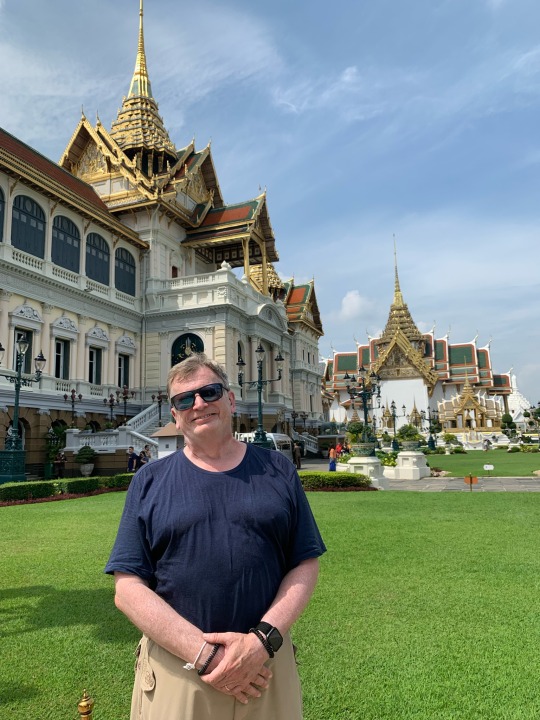
Mind you, all of that was in a SINGLE complex, and those pictures cover about a tenth of what was there.
Our next stop would be the Wat Arun, and we decided to go there by boat through one of the klongs.
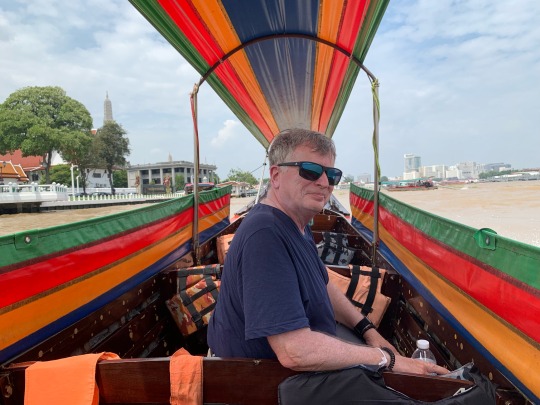
This trip led to an entirely different vision of Bangkok. At one point, all that was missing were fireflies and repeated choruses of “Yo ho! Yo ho! A pirate’s life for me!” for us to have ventured accidentally into Pirates of the Caribbean at Disney World.
But even that isn’t a really accurate comparison. I don’t recall Disney World featuring the long, alligator-like lizards known as “water monitors.”

Or having floating markets where a woman in a boat would sail up next to you and try to sell you cold drinks or souvenirs.

At one point, we passed close to Wat Pak Nam, with a Buddha nearly large enough to compete with the one at Pagoda Khai Nguyên in Hanoi.
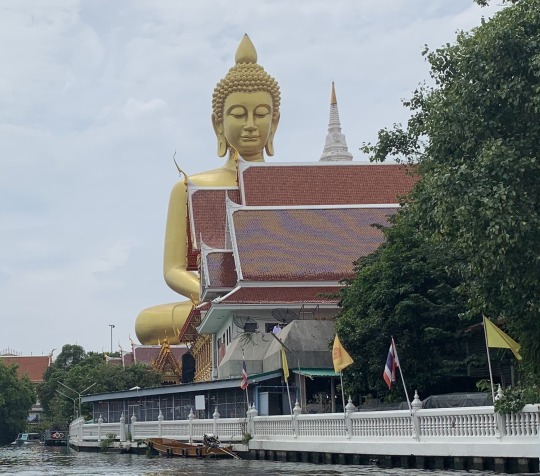
2 notes
·
View notes
Text
Day Twenty-Six, Part One: A Day in Bangkok
I’ve got to admit that, even after nearly four weeks of travel in four different countries, Bangkok could still overwhelm me. There’s only one word for the places we went today: breathtaking. Every time you turn around, there’s a scene that’s even more spectacular than the last. Neither my words nor my photographs will, I’m sure, do the city justice, but it is undoubtedly a place like nowhere else on earth. No wonder Jim Thompson took up residence here.
To begin with, you have to understand that Bangkok isn’t the real name of the city. The real name (and I’m not making it up) is Krung Thep Mahanakhon Amon Rattanakosin Mahinthara Ayuthaya Mahadilok Phop Noppharat Ratchathani Burirom Udomratchaniwet Mahasathan Amon Piman Awatan Sathit Sakkathattiya Witsanukam Prasit. When my guide, Rich, pronounced it, it almost sounded as though he were singing a pop song. Of course, if you only had a four-week vacation, and you said that one of the places you wanted to go was Krung Threp etc. (or, in honor of Yul Brynner, “Etc., etc., etc.”), your four weeks would be up, and you wouldn’t even have left the travel agency yet. So, Bangkok (meaning “The Village of Wild Plums”) is a useful nickname.
Our first stop of the day was the Grand Palace, a place that almost redefines the meaning of both grand and palace.
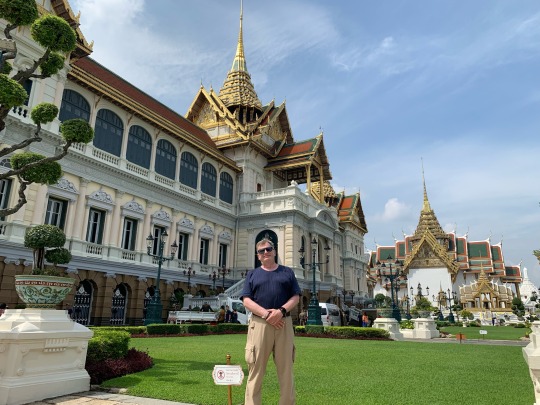
Rather than a single building, the Grand Palace is an entire complex of buildings in white, gold, and a host of other colors that manage to be impressive without the “Oh, come on, now,” overdone nature of the White Palace at Chiang Rai.
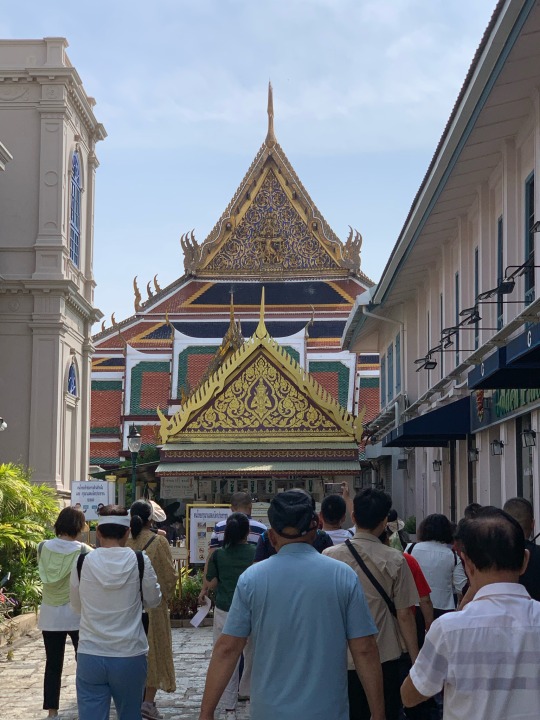
Around one portico is a series of 178 scenes, recently restored, from the Ramayana. Here, for example, is an image of the monkey army pledging its loyalty to Rama.
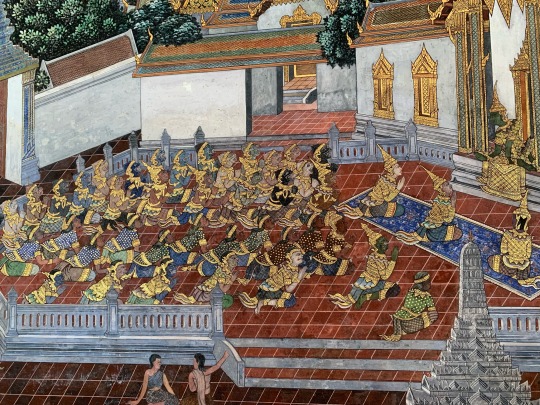
Demon figures guard certain doorways.
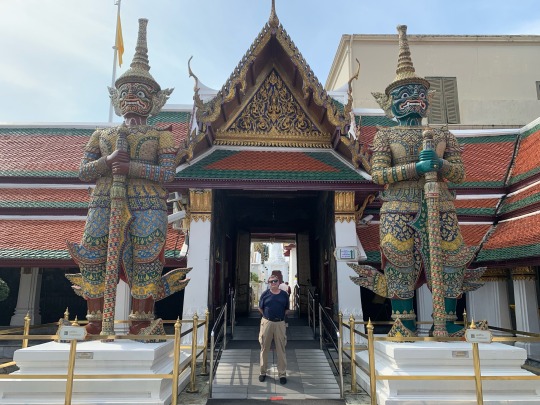
The quality of the carving and painting is exquisite.

A large gold stupa stands surrounded by smaller stupas, each of which is impressive by itself.
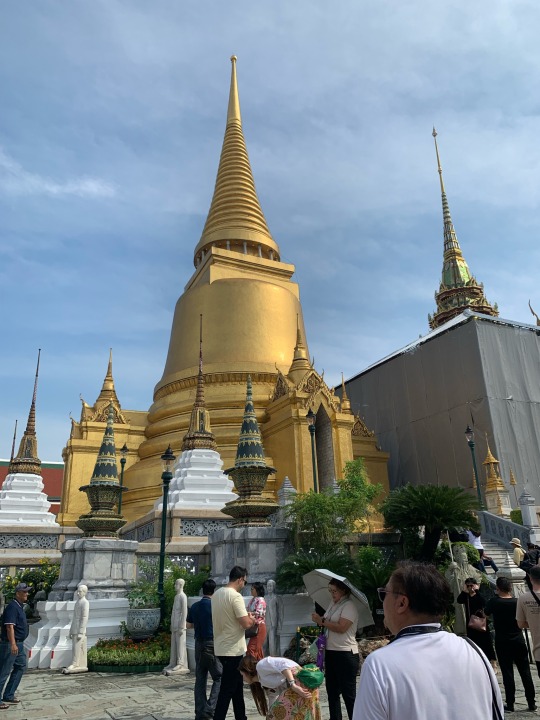
Around each corner is another phenomenal building, such as this one
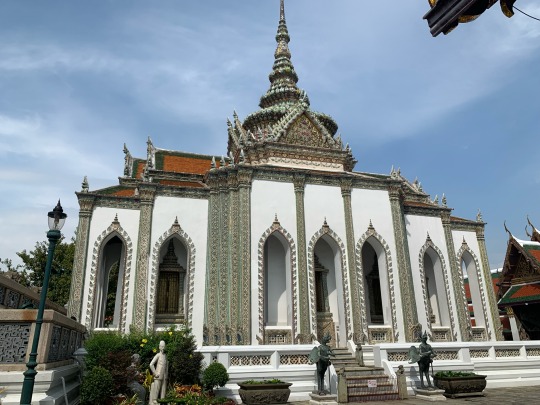
and this one.

Golden Naga snakes lead up to gold inlaid doors.
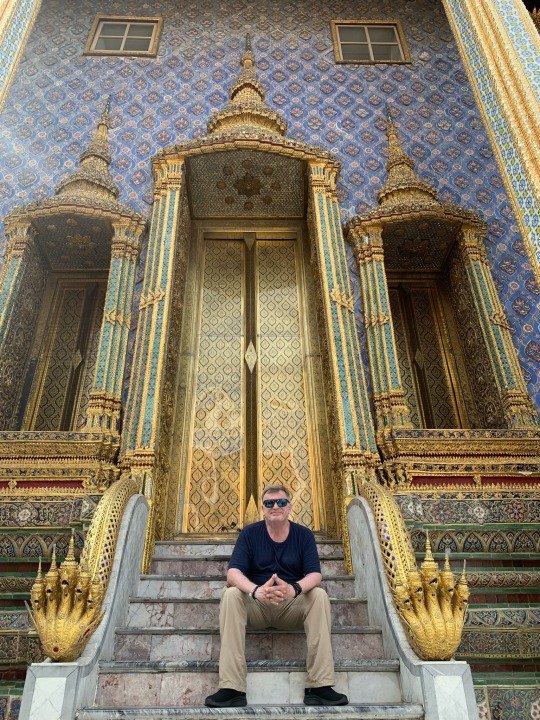
On one wall, in another scene from the Ramayana, the monkey king, Hanuman, pursues the mermaid, Suvannamacha. (This story would become important again later in the afternoon when we saw it re-enacted at a dance recital.)
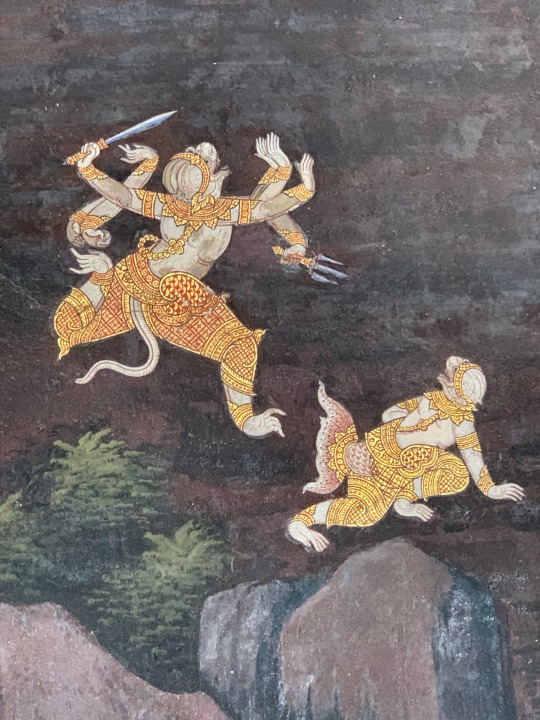
3 notes
·
View notes
Text
Day Twenty-Five: A Day in the Life of the Other Jim Thompson
There are those who say I lack the ability to be spontaneous. Or perhaps they'll admit that I can be spontaneous as long as every detail of my spontaneity is carefully planned and approved at least three months in advance. But to these naysayers, I say, “Ha! Let today be proof you couldn’t be more wrong.”
I awoke in Chiang Mai with every intention of calling today’s entry “Repositioning #5” because that was the agenda set for the day: “Transfer by private car without guide from your hotel to the Airport to take a flight to Bangkok (10h10-11h35). Upon arrival at the Airport, please head to the exit gate and look for your driver who will be waiting for you, holding a welcome signboard with your name on it. Then, you will be transferred to your hotel in town by a private vehicle.”
The transfer to the airport and then the flight to Bangkok went according to plan. But then I met my local guide, Rich (or maybe Mr. Rich; I’m not sure whether “Rich” is a personal name, a family name, or merely a pseudonym; I expect the latter), a really friendly young man with an almost Cambodian permanent smile and a love of laughter. While we were waiting for the car, he said, “I have a suggestion. Your hotel room won’t be ready for several hours yet. You are scheduled to visit the Jim Thompson House on your last day. Why not visit it today instead? Then we’ll go get lunch. By that time you could check in.”
That idea sounded terrific to me, so off we set in a midday Bangkok traffic jam to reach the Jim Thompson House.
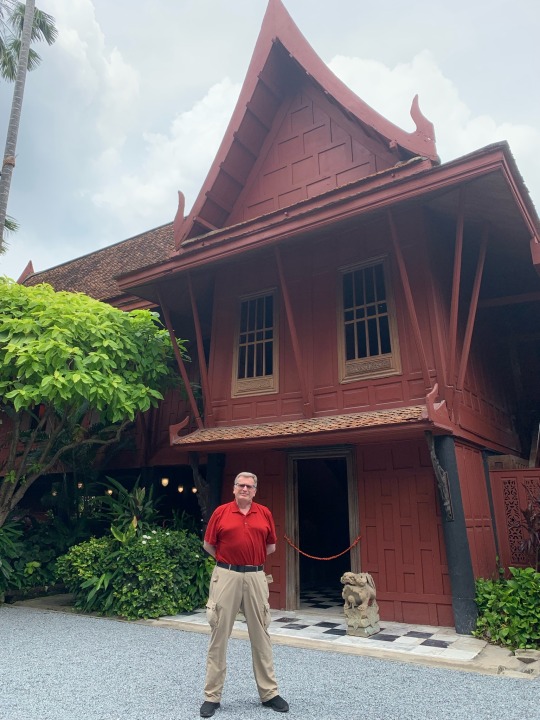
Now, I have wanted to see this house since long before I ever thought I’d actually travel to Thailand, and I wanted to do so for the silliest possible reason. Back when I was a graduate student and a newly-minted college professor, one of my preferred means of relaxation were to read “noir,” hard-boiled mystery novels like The Killer Inside Me, The Getaway, A Hell of a Woman, and The Criminal. The author of all these novels was Jim Thompson. So, when I discovered that Jim Thompson lived much of his life in Bangkok, disappeared under unusual circumstances, and lived in a place sometimes referred to as The Jim Thompson Mystery House … well, that was a place that intrigued me.
There was only one problem, however.
The Jim Thompson who wrote the novels and the Jim Thompson whose house is in Bangkok were two entirely different people.
The owner of the house was an architect who worked for the OSS (the predecessor of the CIA) during World War II. One of his last intelligence assignments was in Bangkok, and he fell in love with the city. He decided to live here permanently. Then, discovering that the cottage industry of making Thai silk was about to die out, he became fascinated with the fabric and the designs often printed on it. He took samples to New York and showed them to friends of his who edited fashion magazines, and they began to feature Thai silk in some of their designs.
Thompson’s big break came when “The King and I” was first a hit on Broadway and then made into a movie. All of Yul Brynner’s elaborate costumes were made of “Jim Thompson silk,” and the former architect/former spy now had a third career: fabric merchant. As his wealth increased, he bought six houses (four from Ayutthaya, the former capital of Siam/Thailand, and two from the Muslim community of weavers just across the river in Bangkok who wove his cloth) and joined them together into an East-meets-West mansion on the banks of one of the klongs (canals) of the Chao Phraya River.
All was well and good until Thompson took a vacation to the Cameron Highlands of Malaysia in 1967. Then, on March 26, he went out for a short walk … and was never seen again. The cause of his disappearance (and presumed death) remains a mystery. Some say he was kidnapped and then murdered, a random victim of a random crime. Others say he was still doing espionage work and was investigating something to do with the war in Vietnam, causing himself to be killed by an enemy agent.
And that, you have to admit, is a far more mysterious ending than that of the author Jim Thompson who simply died of a stroke at the age of 70 in 1977 after a lifetime of alcoholism.
The architect/spy/fabric exporter Jim Thompson, on the other hand, had filled him home with Thai art, such as this rare wooden Buddha (most Thai Buddhas are bronze)

and this sandstone Buddha.
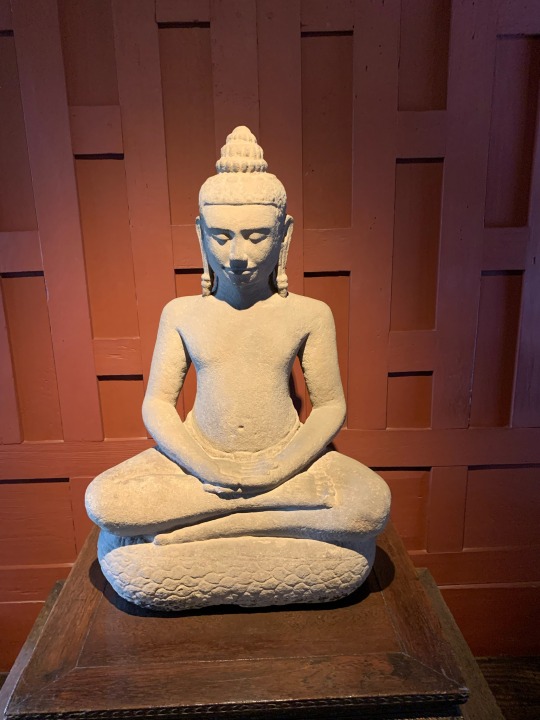
He also collected ceramic works, like these pots that have no lid:
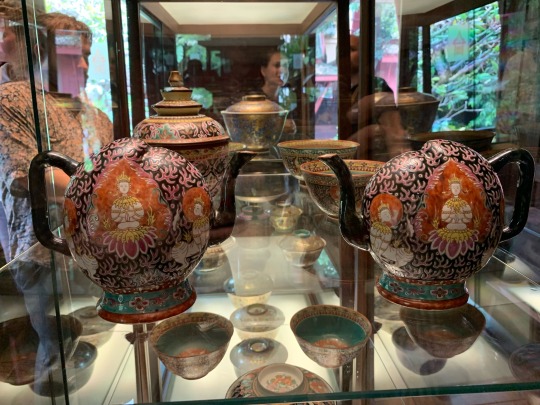
They are actually filled through a hole at the bottom.

Like the Confucius Cup in Hoi An, it's the level of the liquid itself that keeps it from running back out through the bottom. The claim is that, without a lid, the contents don’t oxidize as quickly and thus remain fresher longer.
Thompson’s dining room table consisted of two Chinese gaming tables set side by side.

His living room is open and spacious, looking like the perfect place to relax and read a novel by the other Jim Thompson.
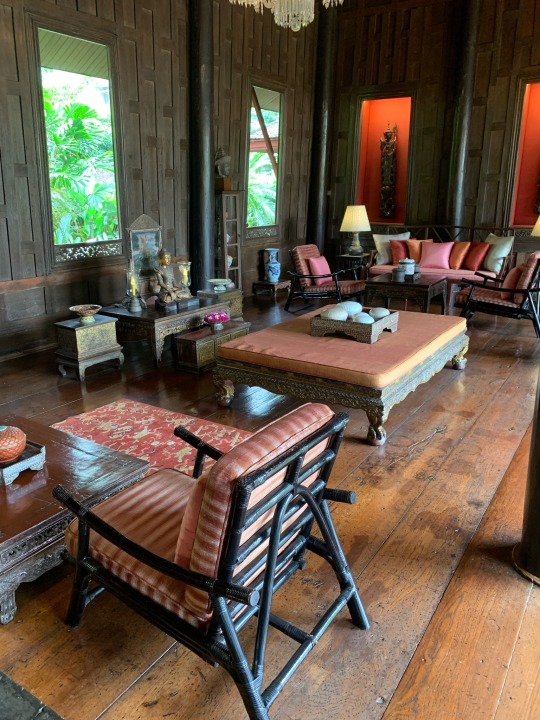
His bedroom is set off from the rest of the house by a set of doors that once led into a pawnbroker’s shop.
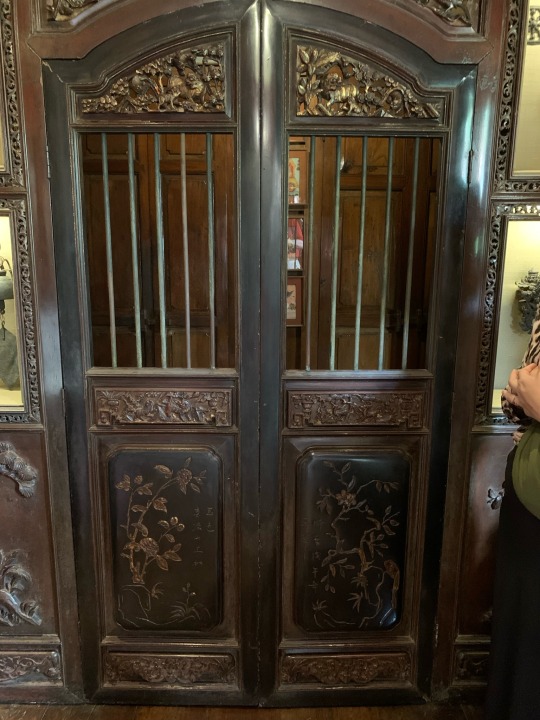
In his bedroom are two horoscopes. The one on the left is his birth horoscope. The one on the right is (reportedly) a prediction that something sinister would occur when he was 61 years old. He was born in 1906 and disappeared in 1967, so …
His bedroom was simple and elegant.

Traditional Thai houses are built on stilts to protect the furnishings from flooding. Today the area beneath the house, which would have been plain in Thompson’s time, is decorated for visitors like me.

At the end of the tour, Rich suggested that we get sandwiches in the Jim Thompson Cafe. There were four sandwiches on the menu, and I ordered the ham and cheese. Unfortunately, the cafe was out of everything except tuna salad, so Rich said, “How about a tuna salad sandwich?”
You would think that, with all the plays I acted in earlier in my life, I could better conceal my emotions. But frankly, my face is often a dead giveaway for whatever I’m thinking even when I believe I’m being perfectly composed. So, less than a second after asking this question, Rich said, “Okay. We can find another place.”
Apparently, Rich can be spontaneous, too.
3 notes
·
View notes
Text
Day Twenty-Four, Part Two: A Day in Chiang Rai
A model in the Opium Museum illustrates the military operation undertaken by the Thai government to destroy the centers where opium was made in neighboring Laos.

Indeed, the proximity of Laos is integral to the next place we visited: the Golden Triangle, a corner of Thailand from which Myanmar and Laos are separated from the country only by rivers.
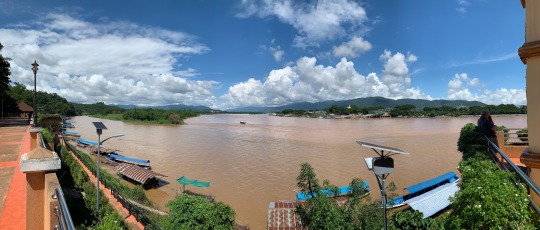
It would be a more than four-hour drive back to Chiang Mai, so we split it up, stopping first at another temple known as Wat Chedi Luang (“The Very Old Monastery"). There, in addition to a majestic Stupa,

we saw a large gong with a wonderful, low, resonant sound. You strike it three times for good luck.

The next stop on the road back to town was … well, you’d better read the name for yourself:

That peculiar title is due to the fact that it is a non-profit restaurant (the “Cabbages” part) that was begun by a wealthy doctor as a way of combatting HIV by also distributing free condoms.
We returned so late that the car couldn’t drop me at the hotel. The Sunday night market had begun, and the streets were closed to traffic. As I was walking to the hotel, I came across another wat that serves as a meditation instruction center.

I made a brief detour into it and found a group of people already in meditation, using the vipassana tradition. Since, however, the lotus position was required for participants, I quickly realized that my own inflexibility would have left me unsuitable as a student there.
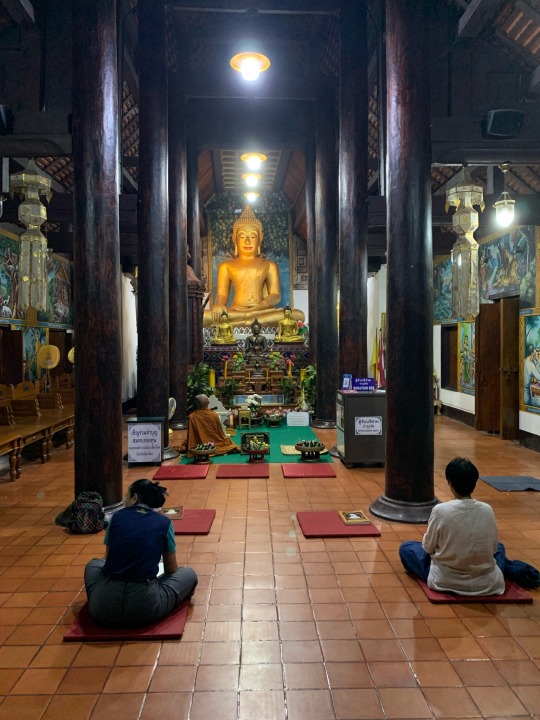
By this time, I was very hungry, so it was time to brave the night market in search of food.
2 notes
·
View notes
Text
Day Twenty-Four, Part One: A Day in Chiang Rai
Today was devoted to a full-day trip from Chiang Mai to Chiang Rai. Now, if those names seem confusing, it’s actually quite simple. Chiang simply means city. Rai or Mangrai was the first king of Lana, the predecessor to Siam/Thailand. And mai simply means big, as in the Wat Mai in Luang Prabang. So, Chiang Mai = The Big City, and Chiang Rai = Rai’s city.
Our first stop, about an hour outside of Chiang Mai, was a hot spring.
When we returned to the city late in the day, the geiser was even more active. Apparently, that tends to occur in the afternoon.
The water of the hot spring is so Hotel that people actually boil eggs in it: seven minutes for chicken eggs; two minutes for quail eggs.

A busload of Chinese tourists was also enjoying the hot springs by soaking their feet in the water.
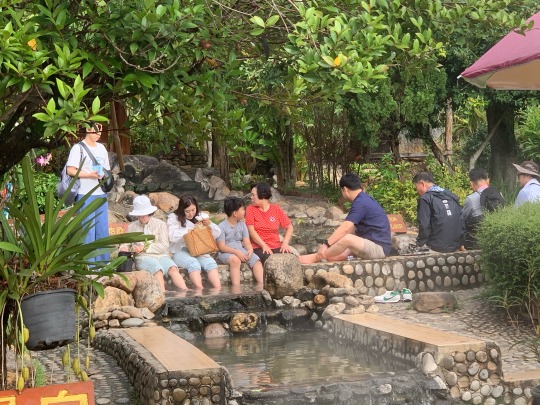
I decided that I’d pass on that treat.
About two hours later, we reached Wat Rong Khun, also known as the White Temple. Now, I’d been really looking forward to this temple since yesterday, when we were walking down the steps from the mountain temple. I overheard one person tell another that he absolutely HAD to go to the White Temple because it was the single best temple anywhere, even more impressive than the mountain temple.

Well, everyone has their own taste, I suppose, but the White Temple just wasn’t my cup of tea. Nor was it what I thought it would be. First, despite incorporating the ruins of an ancient temple, the buildings I saw were no earlier than the twenty-first century. Seriously. They’re the work of an artist by the name of Chalermchai Kositpipat who comes across as having the personality of Elon Musk and the taste of Donald Trump. Nothing that can be done to make the temple gaudy, tacky, and “over the top” has been overlooked.

That’s the second point about why I was disappointed. The outside of the temple is made of concrete painted with bright white paint and inlaid with bits of mirror to make it glitter like something Elvis Presley might have worn.
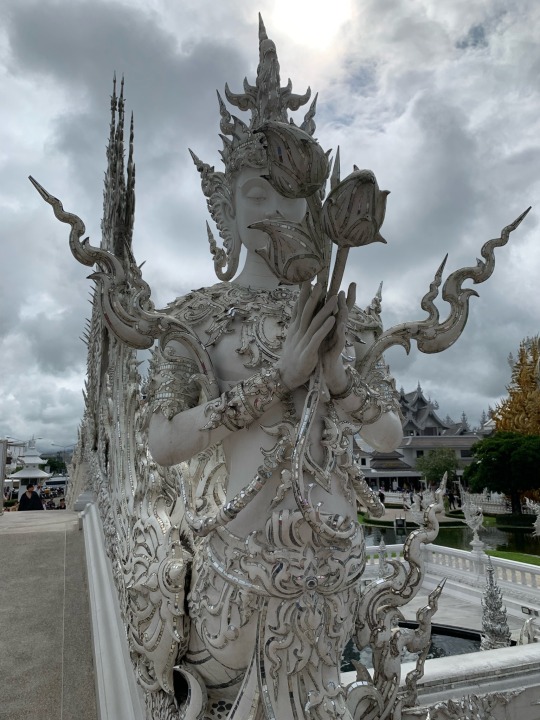
Third, the comparison to Elvis Presley is not an exaggeration. The symbolism at the temple is, at times, downright weird. In addition to traditional Hindu gods, the figures that are depicted in the main temple as saving mankind include Superman, Batman, Spider Man, and … um … Michael Jackson.
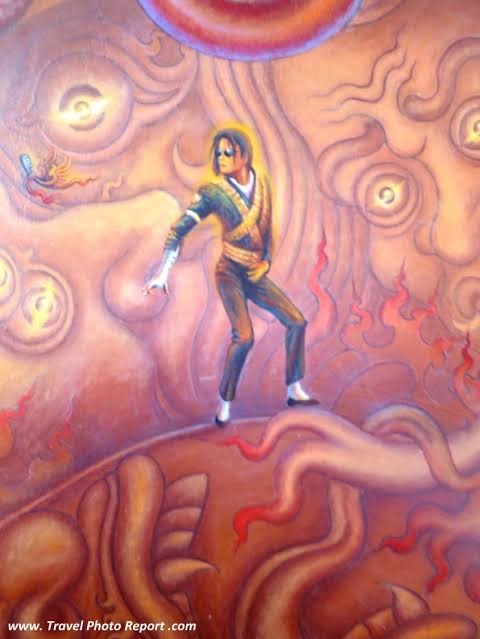
Note that the photo above had to be dowloaded off of the Internet. A sign said that we couldn't take photos inside this section of the temple, and as a rule-follower …
The decor of the White Temple was so over-the-top that I refrained from calling this place “Wat Disney" … aloud, at least, but I thought it often enough.
The temple complex is nominally Buddhist, but with strong Hindu influence. It’s supposed to be a microcosm of the universe. A moat surrounding the buildings represents the ocean. The lowest zone depicts people suffering in hell.

The main temple depicts the battle of good (Michael Jackson et al.) against evil (Osama bin Laden and other terrorists). The paradise section cannot be entered, and the nirvana section is not yet complete.

Almost as a relief afterward, we stopped at the Opium Museum, which traces the rise, development, and eventual eradication of the opium trade in the area. This was actually my favorite part of the day. On display is an assortment of “pillows” that opium users would recline on while smoking the drug,
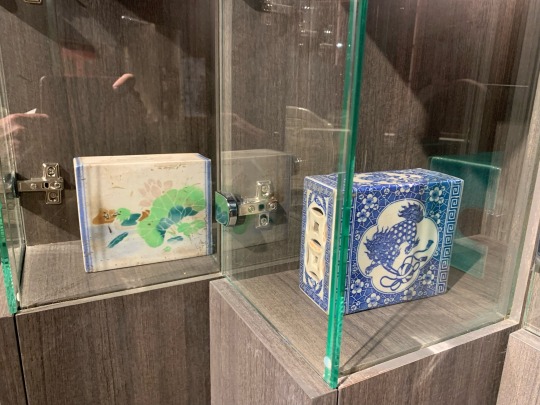
and a large array of opium pipes.

2 notes
·
View notes
Text
Day Twenty-Three, Part Three: A Day in Chiang Mai
The next item on the agenda was a drive up to the Wat Doi Suthep, a temple that is situated on a hill, 3,400 feet high. Our car could only go so far. To reach the summit, you can either take a funicular or climb the 306 steps up to the top. Since it was raining, we opted to take the funicular, which is actually not that much longer of a ride than the Fenelon Place Elevator in Dubuque, “the world’s shortest and steepest scenic railway” … except that this route wasn’t all that scenic: The entire journey takes place in an enclosed tube, so you really don’t see anything until you get to the top. Then, with a thick mist caused by the rain, I didn’t get to see much there, either. You have to imagine the spectacular view of Chiang Mai that would be behind me on a clear day.

The site was chosen when relics of the Buddha were placed on top of an albino elephant. The elephant began to climb the hill, paused twice, but stopped and died at the top. It was thus decided that this would be the site of the temple.

While nominally Buddhist, the temple also honors the Hindu god Ganesha.
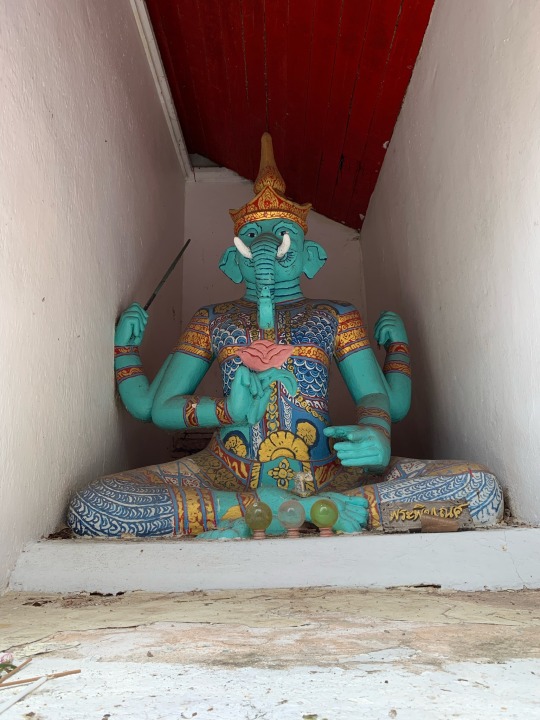
This temple is royal, a fact that is signified by the golden “umbrella” behind me:
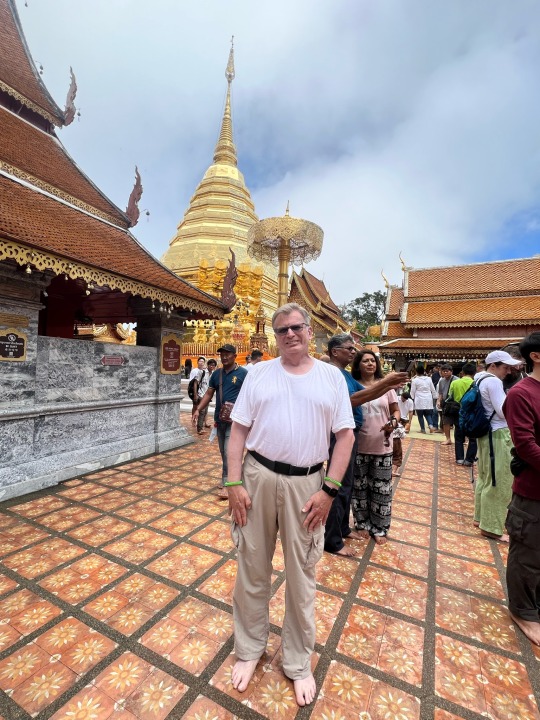
The atmosphere at the temple is reverent but also festive. One of the monks gave me a blessing,

showering me with numerous droplets of holy water and uttering an incantation that, since it included the English words, “happy, happy, lucky, lucky” seems to have been adapted for my benefit.
No one had been waiting for a blessing when I arrived, but a queue quickly formed.

Apparently, I’d started a trend.
The rain showing no sign of stopping, but I elected to walk down, anyway. One funicular ride was enough.
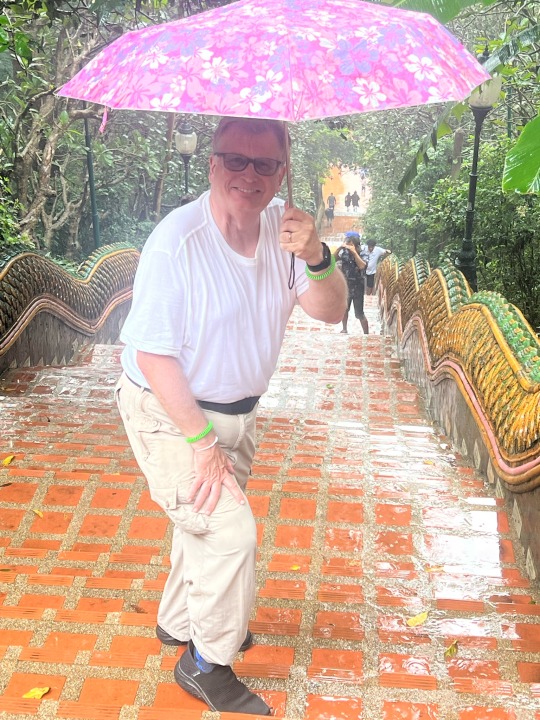
When I got back to the hotel, the woman who'd led yesterday’s herbal ball project invited me to join in today’s activity: the creation of the long paper flags or streamers known as toongs.

It may be my imagination, but I could've sworn I saw a look of trepidation in her eyes as she asked me to join in. When I politely declined, that look was replaced by one of relief. Good deed for the day, done!
2 notes
·
View notes
Text
Day Twenty-Three, Part Two: A Day in Chiang Mai
The trishaw ride ended at Wat Chedi Luang, site of an enormous pagoda that was partially destroyed by an earthquake in 1545.

A model illustrates how the pagoda originally looked.

Around the pagoda are more modern statues of the kings

and queens who played a major role in Thai history.
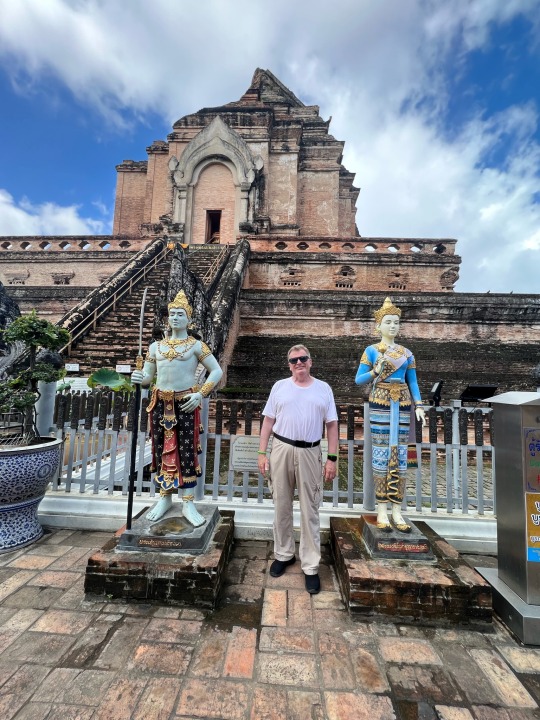
Cannonball Fruit trees (technically sala trees) were in bloom and laden within their massive fruit.

Now, I’d encountered Cannonball Fruit trees in Vietnam, but I hadn’t been aware of their significance then: It was under this type of tree that the Buddha is said to have been born.
We continued on to the Wat Phra Singh, where a huge golden stupa is supposed to contain relics of the Buddha.

Just as the Prabang pose was common to the Buddhas in Luang Prabang, so is the Buddha with the bhumisparsha mudra common to the images at the Wat Phra Singh. This mudra, formed with all five fingers of the right hand extended to touch the ground,
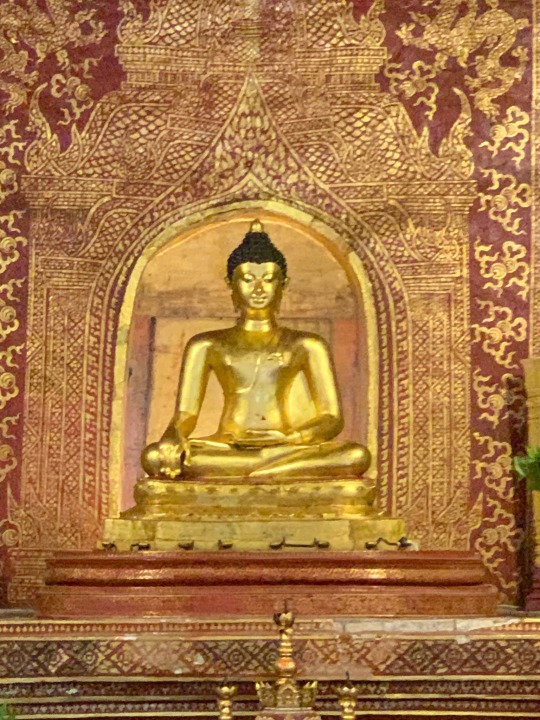
symbolizes the Buddha's enlightenment under the bodhi tree, when he summoned the earth goddess, Sthavara, to bear witness to his attainment of enlightenment.
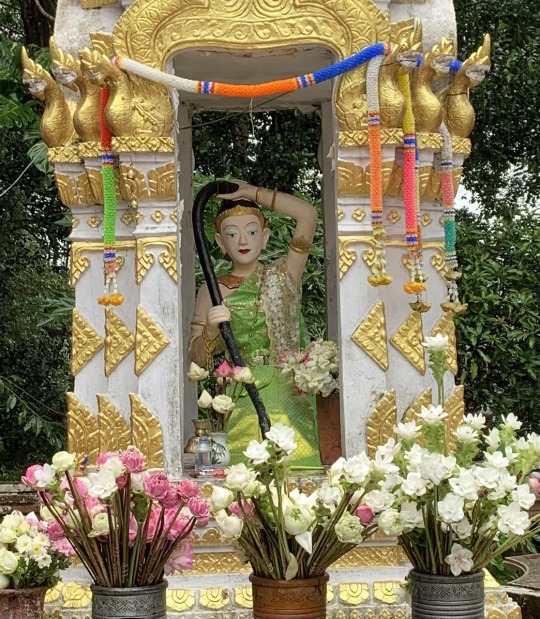
A Buddhist monk was offering blessings to the faithful in that temple.
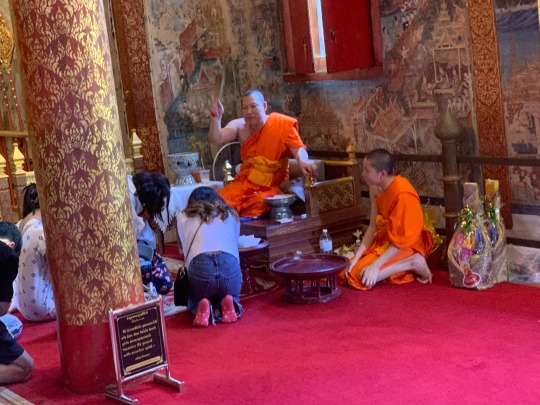
2 notes
·
View notes
Text
Day Twenty-Three, Part One: A Day in Chiang Mai
The day began at Muang Mai Market, a farmers’ market that sells everything from vegetables to school uniforms.

Among the food on display was dried shrimp,

dried fish lungs,
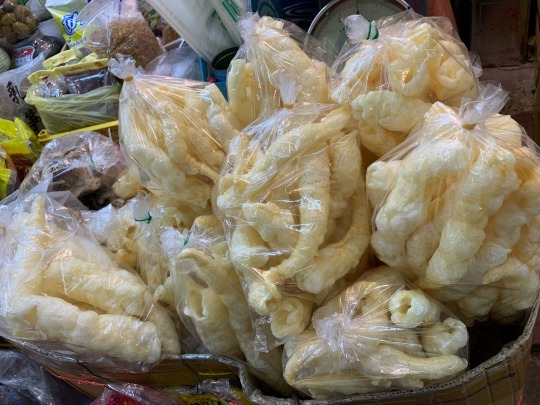
and a wide variety of flavored caramels.
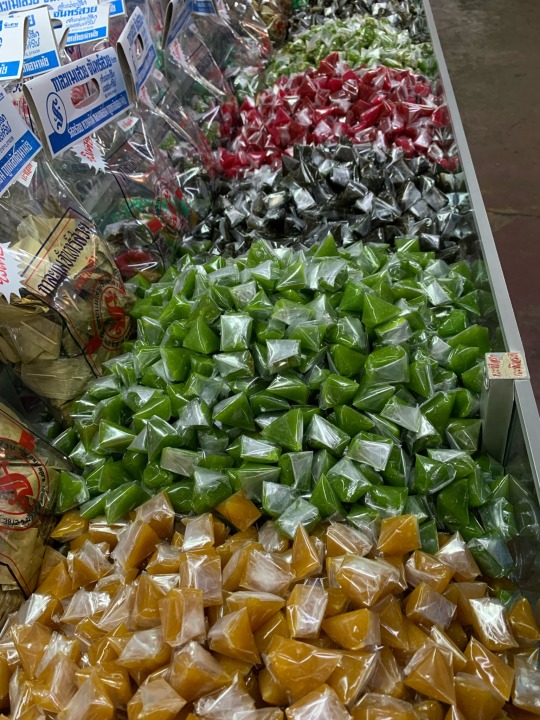
Certain people in Thailand follow the custom of burning small paper replicas of everyday items in the belief that their deceased ancestors need these things in the next world. For example, you might consider providing your deceased grandfather with a complete outfit, including shirt, tie, credit card, Rolex, and mobile phone,
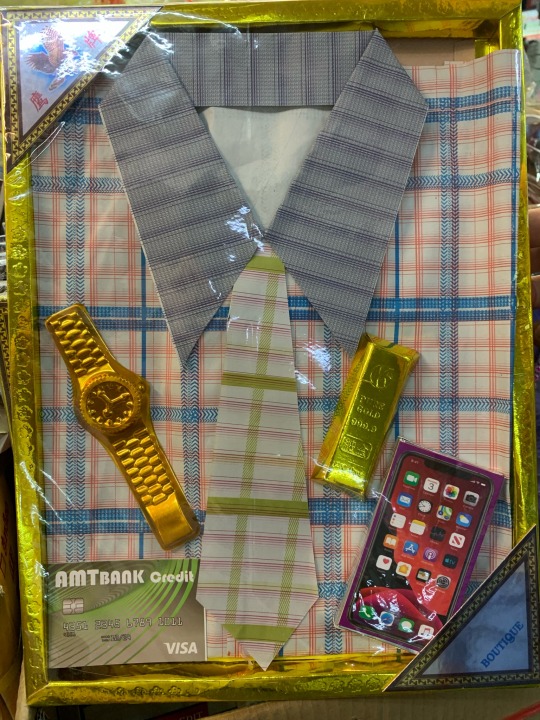
or perhaps a nice BMW,
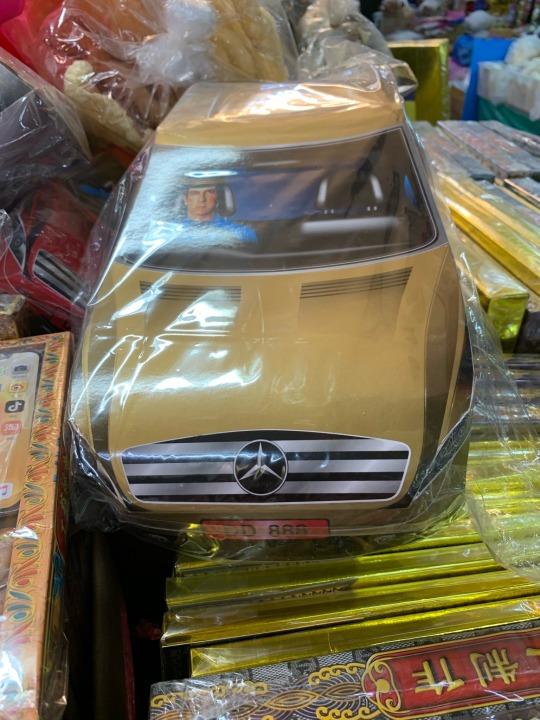
or even an entire house.

I then got a chance to tour the old city by trishaw, a human-powered vehicle similar to the cyclos I experienced in Hanoi, with one important difference:

The Vietnamese cyclo driver pedals from the back and pushes you along. The Thai trishaw driver pedals from the front and pulls you along.
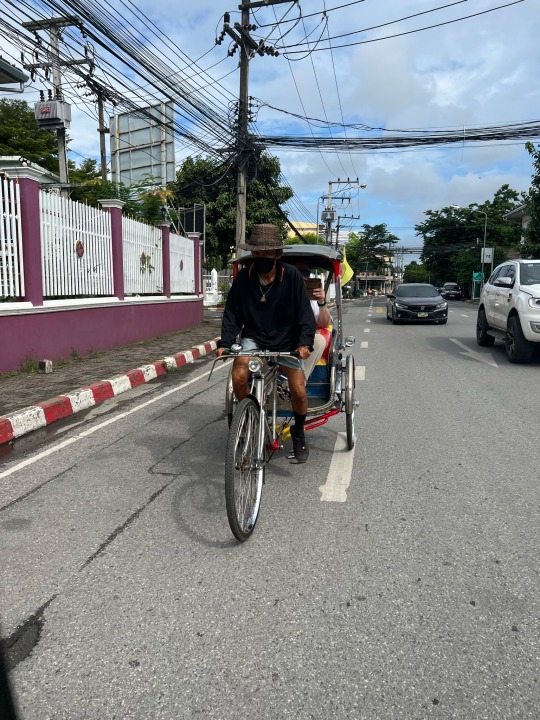
The Thai version thus limits both your view and the amount of breeze you get as you cruise along the streets.
2 notes
·
View notes
Text
Day Twenty-Two: Repositioning #4
The major goal today was to move from Laos to Thailand, the last of the four countries I’m visiting on this trip. The transportation couldn’t have gone more smoothly. The flight even arrived a few minutes early. Passport Control was a breeze. And my guide, Sai, was waiting for me just outside the gate. We got to the hotel about 3:00 and checked in.
That’s when the Craft Gods decided to have yet another go at me.
As the desk clerk was showing me where my room was, she said that the hotel has special activities each day, outside by the tree that gives its name to the hotel: Tamarind Village. Today’s activity was making herbal balls (essentially sachets). Would I like to do that?
Now, not having anything else except dinner on the agenda for the day, I said, “Sure. What time?” The answer was 3:00. Which meant that I only had time to throw my suitcases in the room and set off to make herbal balls. How hard could that be, right?
Ha!
You recall my experience dyeing fabric? Well, today I had that experience on steroids. I’d be shown what to do, imitate as closely as I could, and then hear “No!” At this point, the partially-made herbal ball would be ripped from my hands, and (in the habit of crafts teachers everywhere, it seems), I’d be told to start over again.
So, here is the scene, and I promise you there’s no exaggeration. This was an activity intended mainly for children. So, for the approximately half hour I was there, platoons of seven- and eight-year olds came up, imitated the instructor, and went off to give their completed projects to their moms and dads in fewer than five minutes. Fewer than five minutes. I’m not kidding.
Meanwhile, all I’m hearing is “No!” The herbal ball is snatched away, deconstructed, and given back to me to start again. "Do it again!" Then (and remember: I'm telling you the absolute truth), when I’m FINALLY done, the judgment is “Not so good. Here do another.”
And suddenly I’m back in detention.
Here are the results of my forty minutes of labor:

The first, unsatisfactory one is on the left. The one on the right was deemed good enough (round, tightly packed) for me to be passed out of Herbal Ball Purgatory and released to be free on my own recognizance.
Now, let me make one thing clear. I’ve got enough self-confidence to know that there are things I do pretty darn well in this life. It’s just that craft projects aren’t one of them. And the consistency of that experience—everyone else succeeding at some simple task almost immediately, while I hear, “No! You need to start again!”—is truly remarkable.
Okay, okay. I know what you’re thinking. “Don’t exaggerate, Jeff. It’s not ALWAYS like that. Think of the day on which you did the phap lam enamel project. Sure, you thought the result wasn’t the prettiest one in the shop, but you got it done in one go. Right?”
Well, I had no idea when I was in Hue that “Jeff’s Continual Struggles With Craft Projects” was to become this trip’s leitmotif, so I … well … I truncated that story a bit.
The enamel image you saw at the end of that story

wasn’t the first one I made. It wasn’t even the second one. It was the THIRD attempt. Here’s how the first one came out:
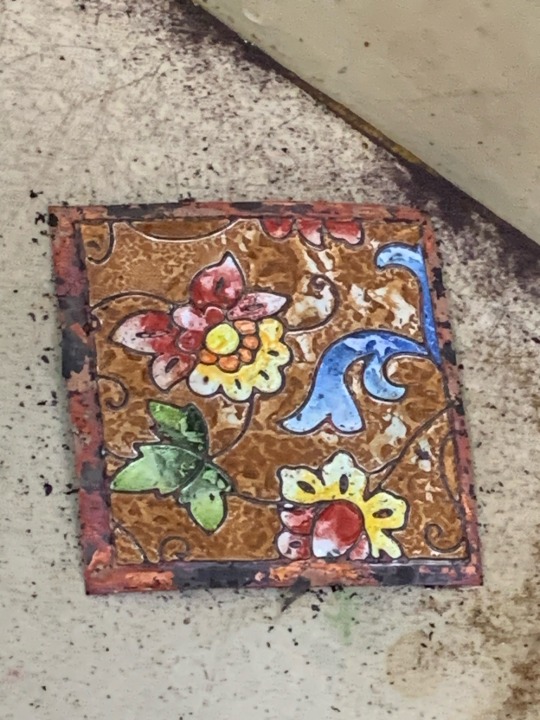
The enamel too thin and the kiln was not yet hot enough, it seems.
Eventually, we got there, but on that day, too, there was a lot of “No!” accompanied by the shaking of heads and pained looks by the masters.
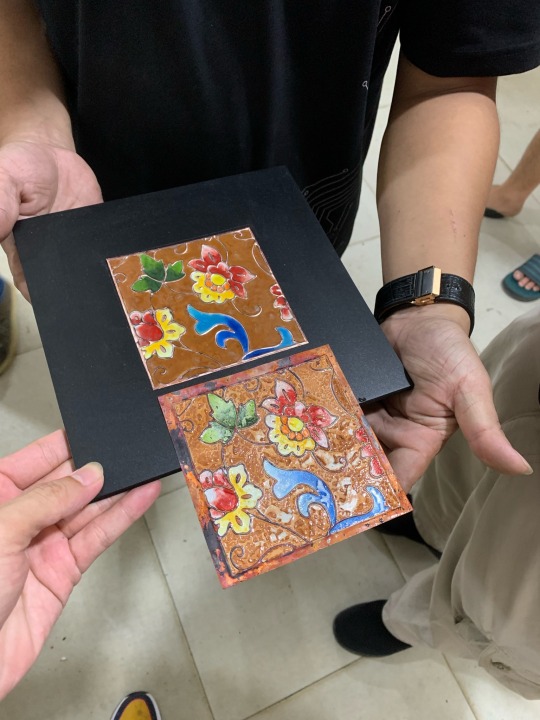
There’s a lesson in here somewhere. I’’m just not sure what it is.
3 notes
·
View notes